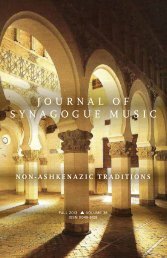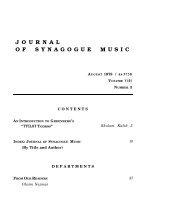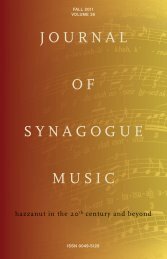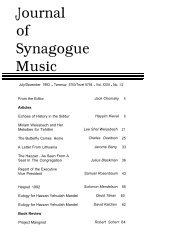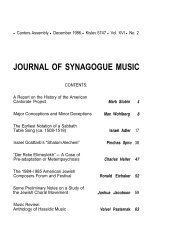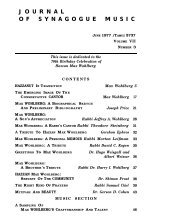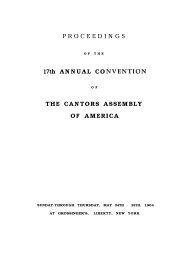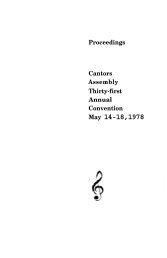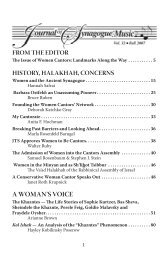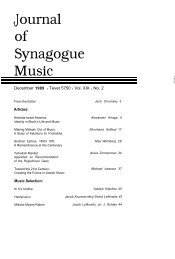ninth annual conference-convention - Cantors Assembly
ninth annual conference-convention - Cantors Assembly
ninth annual conference-convention - Cantors Assembly
You also want an ePaper? Increase the reach of your titles
YUMPU automatically turns print PDFs into web optimized ePapers that Google loves.
The first hearing of the song and a good impression<br />
of it can be, by itself, the best inducement for learning<br />
it.<br />
After the teacher has sung the whole song through,<br />
the most common way to proceed is to divide the song<br />
into small phrases within the children’s memory-span<br />
and to teach it to them by rote.<br />
Even with this simple method, the teacher can be<br />
very imaginative and improvise many approaches to<br />
enliven and add a new element of surprise on each<br />
presentation. Competition between boys and girls and<br />
between classes and sections are usually sure-fire<br />
means to create interest. Just be careful not to overdo<br />
it. Spirited songs (“Matai yavo hamashi-ach”, “Hiney<br />
ma tov”), which are always favorites with children,<br />
lend themselves to hand clapping, foot stamping, finger<br />
snapping and body swaying. Music is not just<br />
sound. It is also movement, feeling and imagination.<br />
The good teacher will utilize and employ, besides the<br />
ear, as many other senses as possible.<br />
A good teacher should never<br />
terest-span of the children.<br />
lose sight of the in-<br />
While coming carefully prepared for his lesson, the<br />
teacher should be ready to change his plans and on<br />
the spur of the moment invent new means and tricks<br />
to suit unpredictable circumstances. A stale routine<br />
can be the teacher’s worst enemy.<br />
It is well to remember that we must not always<br />
expect the children to learn thoroughly an entire song<br />
and that often a mere acquaintance with it is sufficient.<br />
When a music session fails to satisfy, it is very<br />
important to find out immediately the causes and to<br />
eliminate them for the future. It might be the fault<br />
of the song, it might be the fault of the method or<br />
that of physical conditions. It is rarely with the<br />
children.<br />
Teaching by rote is by no means the only method.<br />
The following are types of songs that are most effectively<br />
taught with other methods:<br />
1. ECHO SONGS<br />
2. ROUNDS<br />
3. QUESTION AND ANSWER SONGS<br />
4. CUMULATIVE SONGS<br />
5. TRICK SONGS<br />
6. SONGS WITH A HUMOROUS TWIST<br />
II. BAR MITZVAH INSTRUCTION.<br />
The only comprehensive study of Bar-Mitzvah instruction<br />
that I have been able to find is Hazzan Max<br />
Wohlberg’s article in The Synagogue School. It is a<br />
very valuable contribution. Since this particular issue<br />
is out of print, I want to urge our <strong>Assembly</strong> to reprint<br />
it and make it available to our membership through<br />
The Cantor’s Voice.<br />
- 20 -<br />
In most synagogues it is customary for the Bar-<br />
Mitzvah to chant the Torah blessings and the Haftarah<br />
and its blessings. In some synagogues the boy will<br />
also read the Maftir portion and chant parts of the<br />
Sabbath services of that weekend.<br />
In addition to preparing him for these tasks, the<br />
Bar-Mitzvah instruction will usually include the rituals<br />
of Talis and T’filin, Birkat Hamazon and Kiddush.<br />
In my congregation the Bar-Mitzvah course is held<br />
in two semesters, beginning in September and in February.<br />
The candidate for Bar-Mitzvah will join the<br />
semester that is closest to his 12th birthday. At that<br />
time he also joins the T’filin Club. Each child comes<br />
to class once a week, for a period of 45 minutes on<br />
the day he normally does not come to school. (Ours<br />
is a 2-day a week school, in addition to Sunday school<br />
attendance.) Aside from the rituals and blessings, the<br />
Bar-Mitzvah class will concentrate on learning the<br />
Cantillations and the skill of their application to any<br />
given Haftorah. The text book we use is “The Complete<br />
Bar-Mitzvah Book”,containing all Haftorohs of<br />
the year. Each child also has a copy of the “Hamaftir”<br />
containing his particular Haftoroh. In addition,<br />
I have prepared for my classes a mimeographed course<br />
containing the Cantillations, a series of exercises, music<br />
notes and some basic rules to remember. In his<br />
article, Hazzan Wohlberg outlines a detailed and complete<br />
method for the teaching of the Trop. My experience<br />
has been that most 12-year-old boys easily understand<br />
the simple explanation that each Trop represents<br />
a little melody (or sequence of notes) and when<br />
it occurs in a word in the Haftoroh, that word is<br />
chanted to the same melody. Little elaboration is necessary.<br />
After the children have learned the Trop in a certain<br />
order, the exercises are then introduced to enable<br />
them to isolate each Trop and to chant it properly in<br />
connection with any of its possible combinations. The<br />
application of the Trop to the text is first started with<br />
the blessings before the Haftoroh, which the children<br />
already know by this time. Chanting each phrase with<br />
Trop only first, then with melody only, and finally with<br />
the words, establishes a pattern for them on how to<br />
start learning the Haftoroh.<br />
Each child is then asked to prepare, at home, a few<br />
sentences from his own Haftoroh and at each session<br />
some of these sentences are worked out. The most<br />
important rule, I believe, is to let the children themselves<br />
iron out the difficulties and discover the rules<br />
by themselves.<br />
During the course of the semester, I set aside a<br />
period for consultations, and for helping children with<br />
individual difficulties. I also make it a point to listen<br />
to children who are anxious to show off their progress.<br />
After the completion of each semester, each child is<br />
given individual instruction. Provision is made to<br />
accommodate slower children who need more attention.<br />
I do believe that the tendency to eliminate private<br />
instruction of B’ney-Mitzvah is not a step in the right



